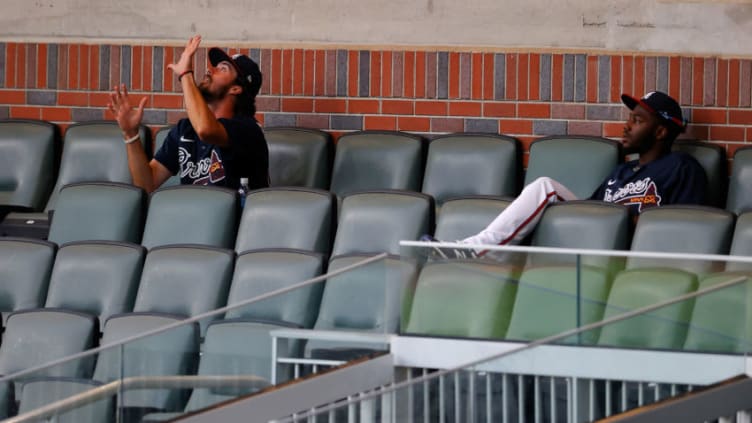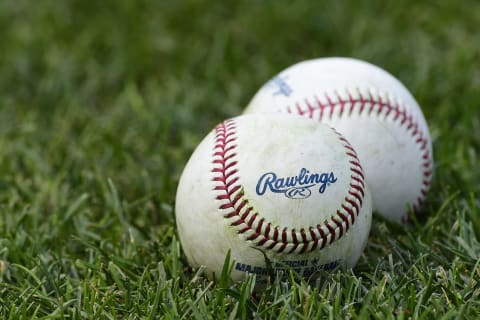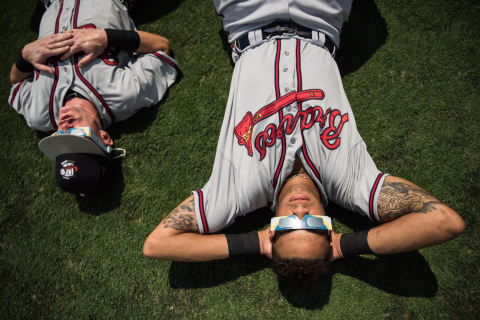Atlanta Braves: how the minor league teams are doing


The Atlanta Braves are what they are today based on the strength of their farm system over the past five years. It’s good, then to keep watch to help predict the next five.
We’ll get to the direct discussion of the Atlanta Braves minor league affiliates in a minute, but first up, I have a story about what we all need to keep in mind about all minor league teams.
A week ago, my local Rocket City Trash Pandas (Angels AA Affiliate in the old Southern League) got into a heckuva game against the Tennessee Smokies (Cubs).
The game went back and forth until being knotted at 6-all after 9 innings. Both teams plated runs in the 10th; neither scored again until the 13th.
In that 13th inning, the Smokies got their “ghost” runner tallied to take an 8-7 lead. In the bottom of the frame, though, the Pandas got to face… a catcher on the mound.
The result might have been predictable, though it came very quickly: Single, RBI Single, intentional walk, Grand Slam… everybody drive home safely as the Pandas win in grand walk-off fashion, 12-8.
I was asked, “why on earth would the Smokies put in a catcher to pitch the 13th? Especially with a lead and a chance to win?”
The answer isn’t especially satisfying to most for the simple reason that we — as fans — always want to see our teams win… especially when there’s a real chance to make that happen. Putting a position player on the mound is usually the sign of the ‘white flag’ waving.
But the minor leagues are not always about wins and losses. They are much more — and primarily — about player development.
In this game, the Smokies had already used six (real) pitchers. They may have been handicapped by two of them going 1 inning or less, but there’s a real possibility that this slate of hurlers was the limit that their coaching staff was willing to use on that day.
Don’t forget: the ghost-runner-on-2nd rule was started in the minors as a means of protecting a team against blowing out their pitching staff and messing with the health of pitchers — not only on the date of a long extra-inning affair, but potentially for days afterward.
So a 13 inning game was probably beyond the expectations and plans of the Smokies that day… and thus they determined “enough was enough”.
Would that decision have been made differently if the Smokies had been in their own home ballpark? Maybe… they didn’t have to directly answer to their fans that day. But this example illustrates vividly how much the minor leagues are so much more about the players and not necessarily the team results on the board.
Now let’s take a look at the Braves’ affiliates.

Atlanta Braves lower affiliate results
Of note: Jake had a deeper look at some individual players recently, so this report will focus more on their teams in general.
AUGUSTA GREEN JACKETS
- Low-A EAST
- Columbia series: 3-3
- Myrtle Beach series: 2-4
- Fayetteville series: 3-2, game 6 just underway.
- Overall: 8-9, third place (of 4) in the South Division of the Low-A league. Columbia is 1st; Myrtle Beach is 4th.
The Jackets have been scoring a lot… and often giving up a lot of runs, too. Games scores have ranged from 1-0 (a win) to 11-10 (a loss). They lost one 12-2 and turned around to win 13-2 on the next day.
The team is 4-2 in 1-run games.
Leading hitters: Willie Carter (.326) and Drew Campbell (1.030 OPS)
Leading pitchers: skipping this category for now: no one has enough innings to be ‘qualified’, and thus the ‘small sample size’ problem would be a real thing.
Speed man: Braulio Vasquez leads the entire league (12 teams) with thirteen stolen bases (caught just once)! That’s all the more remarkable given that he’s hitting just .214 with 9 hits and 10 walks.
If he can get past this Billy Hamilton problem of bad hitting (he does have a .400 OBP, but that can’t be sustained when moving up in levels without a bat), this speed could be a story.
ROME BRAVES
- High-A EAST (12 Teams; member of 7-team South Division)
- Winston-Salem series: 4-2
- Greensboro series: 3-3
- Bowling Green series: 3-2; finale in progress
- Overall: 10-7, second place
Relatively low-scoring club, but still boasts a +10 run differential, which comes from a pitching staff surrendering the third-fewest runs in the league. They are 3-3 in 1-run games.
Leading hitters: Michael Harris (.359, .914 OPS). That average is 2nd in the league while 1st in hits. He’s only walked 3 times, but K’d 25% of his official AB’s (16 of 64).
Cody Milligan is hitting .357 — third in the league.
Leading pitchers: same problem as above… will check on them more in a future edition of this report.

Atlanta Braves upper minor league levels
MISSISSIPPI BRAVES
- AA South League (8 teams; member of South division)
- Pensacola series: 2-4
- Biloxi series: 2-4
- Chattanooga: 3-2, 1 game today
- Overall: 7-10, 3rd/4th place tie (Biloxi)
Mississippi has been struggling to score at all: 52 runs so far, easily the worst in the league (Birmingham has 100!). Of note, this counts a 14-10 loss in a game a week ago… yeah, almost 20% of their runs can in that one game.
On the plus side, the pitching has limited the damage by giving up a league-low 60 runs (most clubs are at well over 70).
The Braves are 2-4 in 1-run contests.
Leading hitters: you might have guessed, but there really aren’t any. Wendell Rijo has a .256 average to lead qualified batters. His OPS is just .630.
There are a couple of brighter spots, though: catcher Shea Langeliers has an .834 OPS (.245 avg) while CF Justin Dean has an .811 OPS (.288 avg. in less-than-qualified ABs so far).
Dean also boasts 5 steals, tied for 2nd in the league (caught once). Still… wondering here when Michael Harris gets promoted to lend a hand.
GWINNETT STRIPERS
- AAA East (member of 20-team league and 7-team Southeast division)
- Charlotte series: 5-1
- Louisville series: 4-2
- Nashville series: 0-5
- Overall: 9-8, 4th place.
Until this Nashville series, the Stripers were flying high. As it is, the Nashville Sounds have been scraping by with their wins: 4 of them have been 1-run victories, the other had a 3-1 final score.
Gwinnett had survived their other 1-run contests at a 3-1 clip. Their run-scoring enjoys a +33 run differential, fueled primarily from a consecutive 19-1, 7-3, and 12-9 drubbings of Charlotte coupled with an 11-1 beating of Louisville.
Leading hitters: of the qualifiers, Abraham Almonte is hitting .349 and Orlando Arcia is at .333. Travis Demeritte (remember him?) is mentionable at .326.
Demeritte is smoking hot overall, too, with a 2nd-in-league 1.233 OPS. Arcia is close behind at 1.090; Almonte 1.014.
Drew Waters has stolen 5 bases (though caught twice) to rank him at the bottom of a large tie for 6th in the league. He’s hitting .268 overall with a .869 OPS.
Leading pitchers: I will mention Connor Johnstone here. In 18.1 innings, he has a 3.44 ERA with a WHIP of 0.60. That latter number is 2nd in the league.
Tucker Davidson (14 innings) has an 0.64 ERA with a 0.71 WHIP. That got him a start in Atlanta last week.
Next. The minor league players report. dark
That’s a wrap on the minors this week. We’ll periodically review these teams and see how things are progressing.